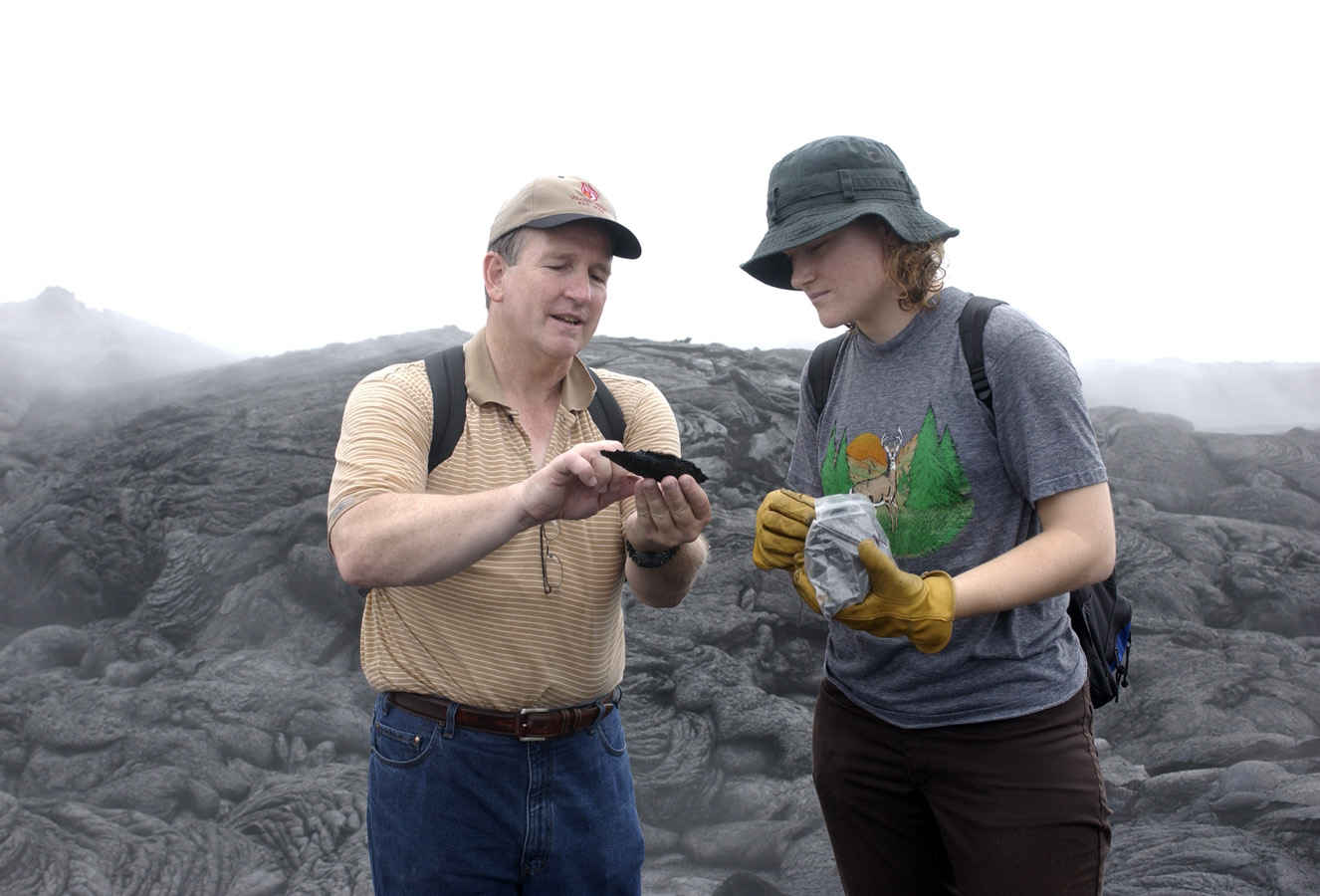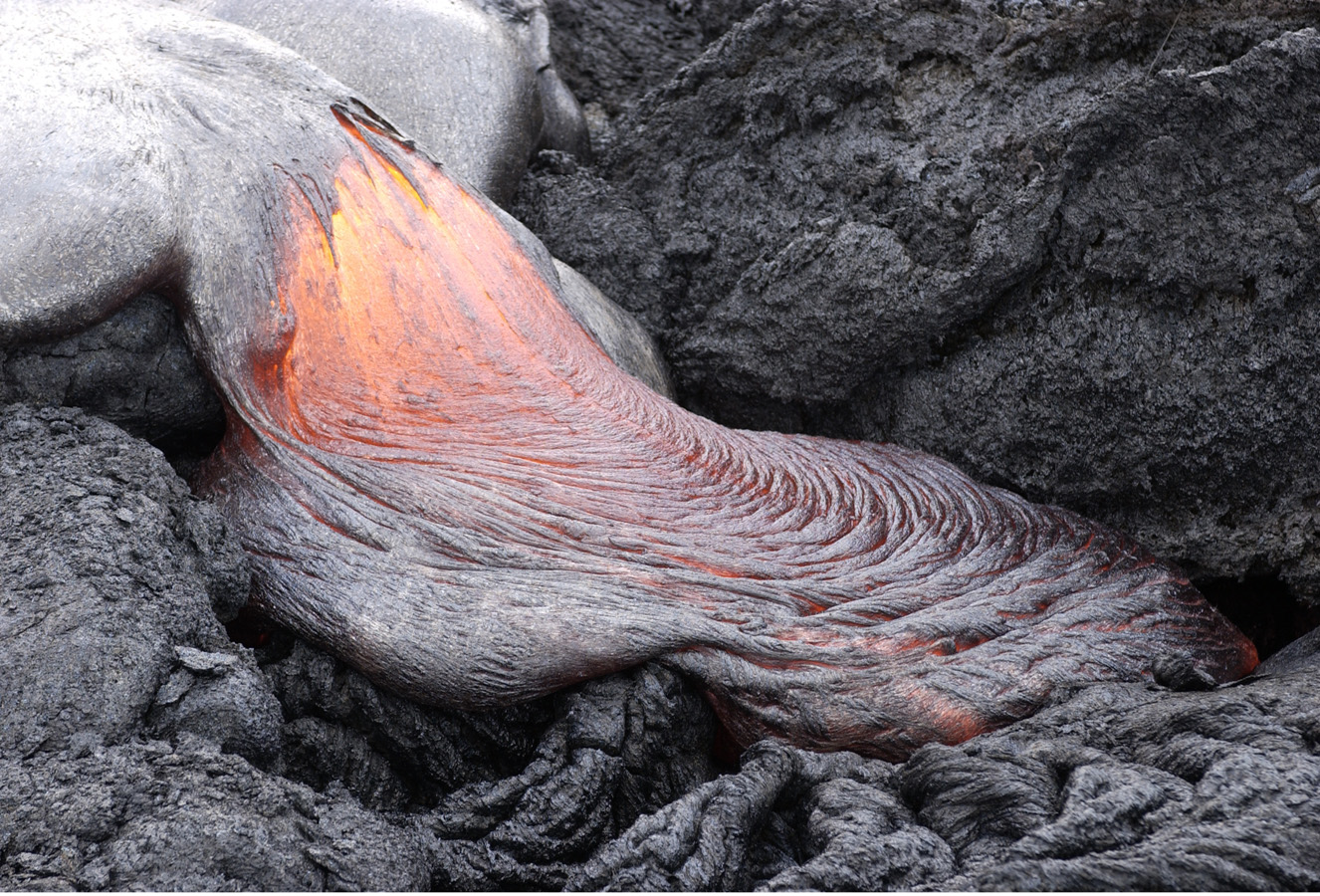Thrusting the iron claws of their hammers into a river of red-hot lava, Brigham Young University students pull back ropy samples of molten rock that stretch through the air like soft taffy.
In the days after Thanksgiving break, this mix of undergraduate and graduate students on a field study trip to Hawaii Volcanoes National Park busily gather newborn rock for further scientific study – part of 20 years of research aimed at understanding the formation of copper, silver and gold deposits. Led by BYU economic geologist Jeffrey D. Keith, the group gathers information particularly valuable to mining companies, like Kennecott Utah Copper, which regularly profit from the volcanic activity of eons past.
"If we can understand the processes involved in the formation of these metal ore deposits, we can come up with better and more efficient means of exploration," says Keith, who will publish a scholarly article on the topic early next year in the geology journal "Mineralium Deposita" – his 17th paper on the subject.
Keith hypothesizes that sulfur and chlorine gases at the base of every ore-related underground magma chamber rise to the surface of the magma, capturing and pooling metal as they go. Eventually, the ore and the magma cool, awaiting discovery by the mining industry.
"The copper and gold deposits of Bingham Canyon (southwest of Salt Lake City) probably formed this way," says Keith, explaining that mining companies exploring for copper, gold and silver might be better off looking for evidence of iron-, sulfur- and chlorine-rich magmas, as this could mark the areas where ore deposits might be formed. By sampling and analyzing fresh lava in the laboratory, he hopes to find further evidence of these gases on the surface of lava to support his hypothesis.
Don Swanson, scientist-in-charge of the Hawaiian Volcano Observatory for the U.S. Geological Survey, says Keith is on the right track.
"This is the first time that these sorts of observations have been made, and they are very intriguing," says Swanson. "There's quite a lot of sulfur in the lava from Kilauea and there is some chlorine, too – both are soluble in water, so it's necessary to gather the samples before they are rained on. Because we have fresh lava flows, this is certainly the right place to gather the kind of samples Dr. Keith needs for his research."
Over the course of his study and teaching, Keith has brought more than 100 students, faculty and alumni to examine these flows and to sizzle the soles of their shoes first hand on Hawaii's lava fields – a craggy and alien landscape straight out of a science fiction film.
Made of barren, glass-crusted rock that crunches and crackles underfoot, some sections of the lava field are smooth and round like burned loaves of bread that have been smashed together in clusters, while others are rough and chunky like the rich, overturned soil of a freshly plowed field. Intricate designs of natural artwork are scattered throughout, as if some hand patiently placed twisted ebony ropes one after the other or meticulously folded a thick, black cloth back and forth, setting it gently on the ground. Occasional wisps of white steam and blue sulfur smoke leak through jagged cracks in the crust.
"Students have seen pictures of lava flows in textbooks," says Keith, whose work is funded by a grant from the National Science Foundation. "But it's an entirely different experience to come here and see them being formed, to walk up close enough that they can feel the heat and see how those individual forms are made and how fast they move. I think that they'll never look at things the same way again."
Because the Big Island of Hawaii is so geologically active, it is one of the few places on Earth where Keith can study volcanic processes as they happen. A 20-minute drive through the national park via the winding Chain of Craters Road provides the setting for an unconventional class lecture – students take in views of the vivid effects of Kilauea volcano as they descend 3,700 feet from its crater to the Pacific Ocean. Along the way they pass lava tubes, steam vents and craters, ending at an old lava flow that covers and blocks the paved road.
From there, the BYU group makes its way on foot across 6 miles of the lava field's demanding and shadeless landscape, pausing occasionally for Keith to explain an unusual geologic formation or answer a student's question about a rock sample. After hours of hiking, the group finally arrives at the volcano's active, surface lava flows, which hiss and crackle as they creep toward the coast across older, solidified flows.
Keith cautiously approaches the flow and uses an iron poker that to this point has served as a walking stick to punch through the thin, silvery skin that forms on the lava as it is exposed to the cooler air. Twisting the poker around, he gradually lifts his prize for the students to see. Fresh lava oozes out of the newly formed hole. The tip of the poker is covered in orange goo that stretches from the hole like warm molasses.
Immediately, they spring to work, gathering samples from the flow using their small rock hammers to mimic Keith's example. As they do, bright orange lava seeps out and is pulled into the air where it quickly forms a silvery coating of its own. The intense heat forces the students to shield their faces with gloved hands and rapidly flee the proximity of the flow to shake the lava from their hammers to the ground. In moments, it has taken on a charcoal-like hue and has cooled to about 300 to 400 degrees Fahrenheit, down from its original 2000-plus degree temperature.
"Nothing compares to this," says graduate student Matthew Harper, from Blackfoot, Idaho, who came on the trip to gather geologic samples for laboratory work related to his master's thesis. "You can't sit in a classroom long enough or watch enough videos to realize the magnitude of what is happening out here - it's amazing to get right up and see rock flow like syrup."
After the lava has cooled sufficiently, other students break off chunks and place them in plastic bags and containers to be studied later at BYU under an electron microprobe, a device that determines their composition. Still other samples are inserted into vials containing distilled water, where salts and minerals in the lava dissolve for laboratory study.
Bill Stavast, a graduate student from Orem, will be doing most of the analysis for Keith. He has studied similar rocks from deposits in Bingham Canyon.
"Hopefully we will be able to make a model that will tip us off to the presence of a nearby ore body," he says.
Taking a moment to step away from the lava collection, Amber Syme, a senior from Orem, reflects on her geology studies:
"This is the culmination of all the classes that I've taken to this point," says Syme. "You start out learning about the basics of geology and then one day you come to the birth of land, it's pretty incredible. It makes me have a greater appreciation for the processes I've learned about in class already."
Although he has been here before, Keith shares his students' enthusiasm.
"It's just really a spiritual experience," he says as his mouth spreads into a grin. "To see new land being created - I'm in awe. I could stand here and watch this all day."























